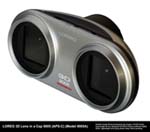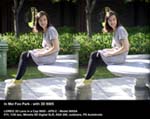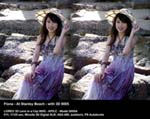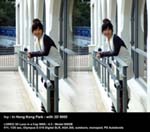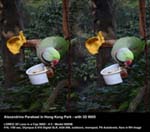| Turns Digital SLR into 3D camera | |
|
|
|
LOREO 3D Lens in a Cap 9005The new subframe 3D Lens in a Cap 9005 (patent pending), in development since 2007, is a sports and portrait 3D lens. The lens has a focal length of 40mm and a stereo base of (interocular distance) of 90mm. There is a version for APS-C format subframe digital SLR cameras and one for 4:3 and Micro 4:3 format subframe digital SLR cameras.
Parallax Compensation3D photographers will be familiar with trying to take closeup photographs with wide image pitch 3D devices. The 3D effect depends on the parallax between left and right images, but too much parallax makes for unnatural 3D, which is difficult to fuse. A 3D lens with a 50mm stereo base is very good for 3D photographs in which the subject is 1.5 - 3 meters away. At the same distance, a 90mm stereo base 3D lens would produce image pairs with excessive parallax, where left and right images are too wide apart to fuse. The 50mm stereo base lens however would not be capable of producing spectacular 3D at 5 meters or more away.The 3D Lens in a Cap 9005 has a focus coupled Parallax Compensation system. When the lens is focused on a subject at a given distance, the image pitch is automatically adjusted within the unit itself to suit the object distance. This works from 1.5m to infinity. The adjustment of the relative positions of the image pair can be viewed in the viewfinder, or with Live View in modern digital SLR cameras. Once a user learns how to use the lens, focusing can actually be done by parallax compensation alone. When the subject appears in the same relative position in both the left and right image in the viewfinder, it will automatically be in focus.
AccessoriesThe 9005 is also equipped with a pair of 58mm filter threads in the front, which can be used for attaching converters, filters and hoods. Lightweight accessories are strongly recommended. Wide angle and tele converters should be selected with care, preferably matched to the 3D lens at purchase. Avoid using converters with too small an optical diameter at the back, as this may cause vignetting.4:3 and Micro 4:3 subframe formatOn Olympus and Panasonic Four Thirds and Micro Four Thirds digital SLR cameras, the 2:1 FOV crop factor brings the effective focal length to 80mm on the vertical side of the image frame, making the 9005 a telephoto 3D lens.With a pair of 1.45x converters, the effective focal length on 4:3 format units becomes 116mm. The wide image pitch (90mm) allows excellent 3D photographs to be taken from 5 meters or more away.
APS-C subframe formatThe 1.5x / 1.6x FOV crop factor brings the effective focal length to 60mm on the vertical side of the image frame. For APS-C format, there are very few tele converters with a sufficient inner diameter to avoid vignetting. Photos taken with tele converters on APS-C format 9005 lenses will most likely need to be cropped afterwards.
Classic Parallel Format 3DLoreo 3D lenses produce classic parallel format 3D pairs, best viewed in their original colours with traditional parallel format 3D viewers, also known as Holmes Style Stereo Viewers. This is a different kind of 3D viewing experience from the more hi-tech methods found in modern TV sets and cinemas. Digital SLRs with movie mode can take 16:9 HD video with Loreo 3D lenses. The result will be two side by side videos, each 8:9, which can be viewed in 3D with a Loreo Pixi 3D Viewer on a computer monitor. It is commonly misunderstood that two 16:9 side by side videos can be taken with Loreo 3D lenses. This is not the case. The 3D glasses provided with 3D TV sets cannot be used to view a classic parallel format Loreo 3D pair (still or video). Most likely it is possible with post-processing, but this is outside Loreo's field of work.
Resources
3D EffectThe 3D effect is achieved by transposing two images through a matched pair of focusing lenses and a reflector housing with four mirrors. Beam splitters designed in the 1960s for SLR cameras have a pronounced keystone effect. The new 3D Lens in a Cap 9005 eliminates the keystone effect. It is a self-contained, integrated mirror assembly and lens system that mounts directly onto the camera body and does not need any supporting lens. This means that it does not work with SLRs which do not have interchangeable lenses, such as the Olympus E10, E20 series of digital cameras.The 3D Lens in a Cap 9005 takes full advantage of the accurate viewing, exposure control and wide range of shutter speeds that SLRs possess. Excellent print and digital 3D images can be produced with this lightweight 3D Lens. Processed 3D prints are ready for viewing with Loreo Deluxe or Lite 3D Viewers. They can also be viewed on computer screens with a Loreo Pixi 3D Viewer.
Fiona - At Stanley Beach - 3D Lens in a Cap 9005 - APS-C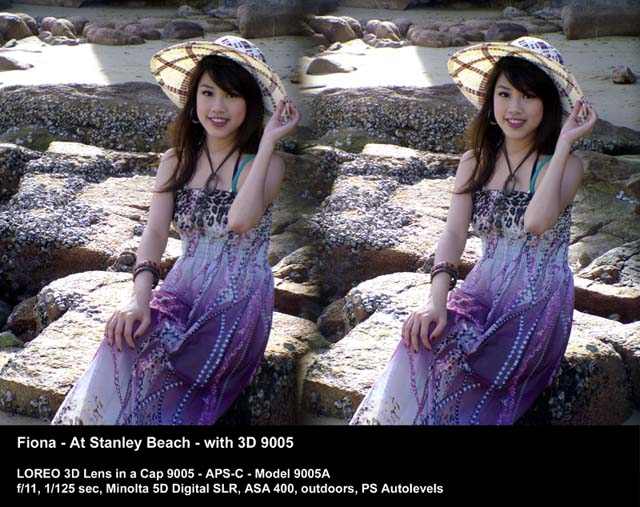
In Mei Foo Park - 3D Lens in a Cap 9005 - portrait - APS-C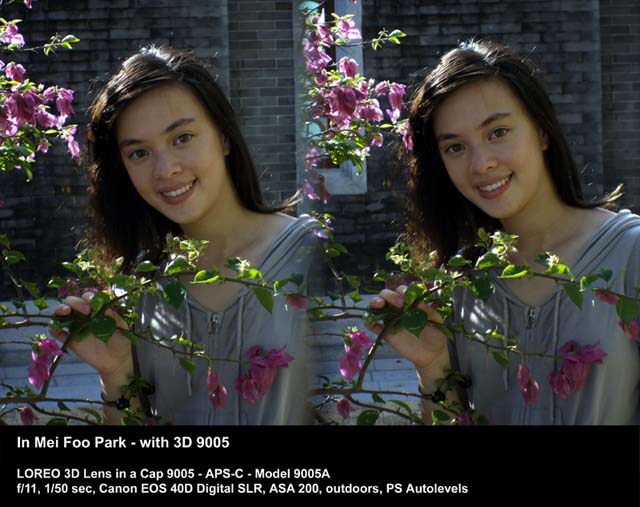
In Mei Foo Park - 3D Lens in a Cap 9005 - APS-C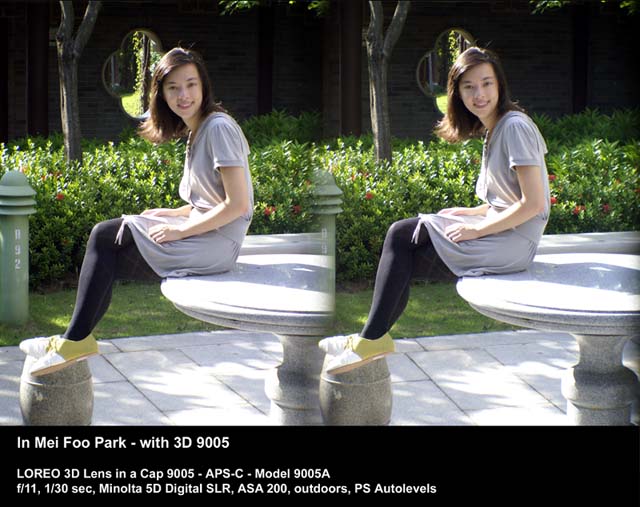
Fiona - In Hong Kong Park - 3D Lens in a Cap 9005 - portrait - 4:3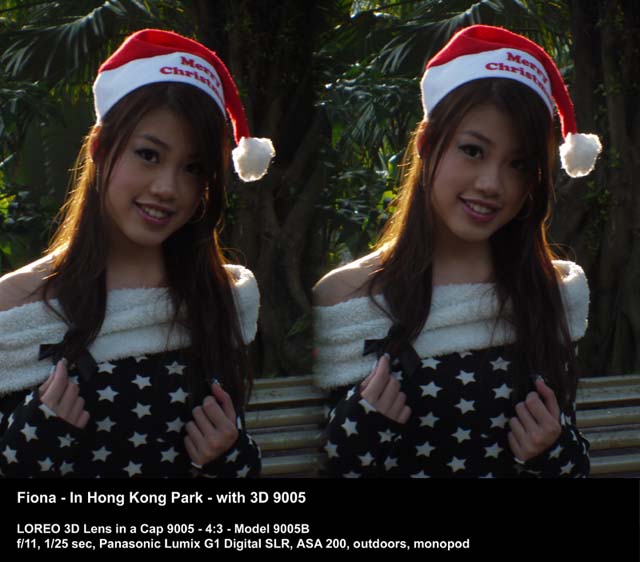
Ivy - In Hong Kong Park - 3D Lens in a Cap 9005 - portrait - 4:3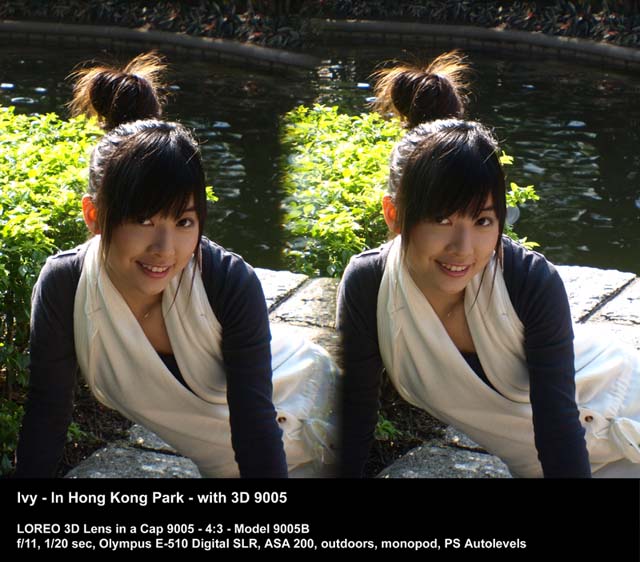
Ivy - In Hong Kong Park - 3D Lens in a Cap 9005 - with wide angle converter - 4:3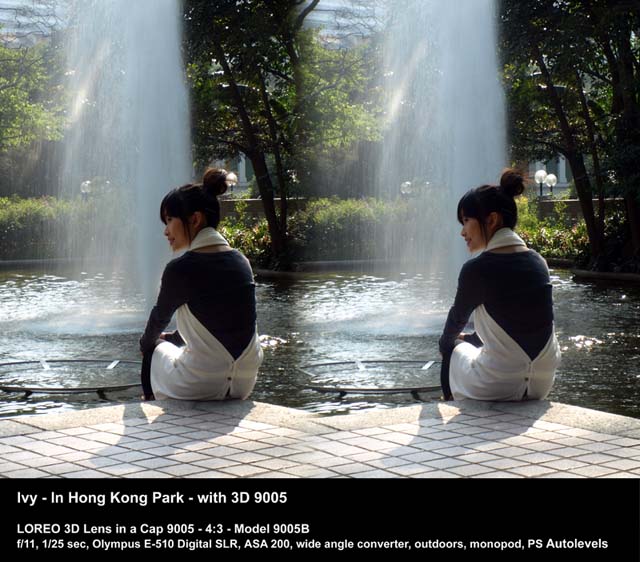
Return to the Loreo Homepage. E-mail: info@loreo.com |
|
